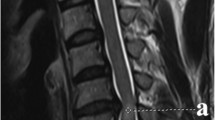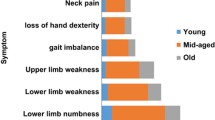Abstract
The purpose of this study was to determine the correlation between Nurick grade and modified Japanese Orthopaedic Association (mJOA) scores in the preoperative and postoperative follow-up evaluation of patients with cervical spondylotic myelopathy (CSM). This retrospective study included 93 patients with CSM who underwent central corpectomy (CC) between 1998 and 2008. Preoperative and postoperative Nurick grade and total mJOA (tmJOA) and lower limb mJOA (llmJOA) score of each patient was documented and the correlation between the Nurick grades and the mJOA scores was studied. At presentation and follow-up, correlation between Nurick grade and llmJOA (Spearman’s ρ 0.901 and 0.886) was better than with tmJOA (0.846 and 0.862). The Nurick grade recovery rate (NGRR) correlated better with the llmJOARR than with tmJOARR (Spearman’s ρ 0.840 and 0.793, respectively). Overall, the correlation of preoperative and follow-up scores and recovery rates was better in patients with moderate myelopathy than in those with mild or severe myelopathy. At follow-up, 78/93 (83.9%) patients had improved in their Nurick grades, whereas 88/93 (94.6%) had improved in their tmJOA scores and 73/93 (78.5%) in their llmJOA scores. Although Nurick grade and llmJOA had good correlation preoperatively, at follow-up evaluation after surgery, there was disagreement in 11.8% (11/93) patients. One of the major reasons for the discrepancy between the Nurick scale and the llmJOA at follow-up evaluation was the ability of patients to regain employment without an improvement in the llmJOA score. As disease-specific scales, both Nurick scale and mJOA score should be utilized in the evaluation of patients with CSM.


Similar content being viewed by others
References
Benzel EC, Lancon J, Kesterson L, Hadden T (1991) Cervical laminectomy and dentate ligament section for cervical spondylotic myelopathy. J Spinal Disord 4:286–295. doi:10.1097/00002517-199109000-00005
Cheung WY, Arvinte D, Wong YW, Luk KD, Cheung KM (2008) Neurological recovery after surgical decompression in patients with cervical spondylotic myelopathy–a prospective study. Int Orthop 32(2):273–278. doi:10.1007/s00264-006-0315-4
Chagas H, Domingues F, Aversa A, Vidal FAL, de Souza JM (2005) Cervical spondylotic myelopathy: 10 years of prospective outcome analysis of anterior decompression and fusion. Surg Neurol 64 Suppl 1:S1:30–35 doi:10.1016/j.surneu.2005.02.016
Hirabayashi K, Miyakawa J, Satomi K, Maruyama T, Wakano K (1981) Operative results and postoperative progression of ossification among patients with ossification of cervical posterior longitudinal ligament. Spine 6:354–364. doi:10.1097/00007632-198107000-00005
Ikenaga M, Shikata J, Tanaka C (2006) Long-term results over 10 years of anterior corpectomy and fusion for multilevel cervical myelopathy. Spine 31(14):1568–1574. doi:10.1097/01.brs.0000221985.37468.0f
King JT Jr, Roberts MS (2002) Validity and reliability of the Short Form-36 in cervical spondylotic myelopathy. J Neurosurg 97(2 Suppl):180–185. doi:10.3171/spi.2002.97.2.0180
Nurick S (1972) The pathogenesis of the spinal cord disorder associated with cervical spondylosis. Brain 95:87–100. doi:10.1093/brain/95.1.87
Rajshekhar V, Kumar GSS (2005) Functional outcome after central corpectomy in poor grade patients with cervical spondylotic myelopathy and ossified posterior longitudinal ligament. Neurosurgery 56:1279–1285. doi:10.1227/01.NEU.0000159713.20597.0F
Rajshekhar V, Muliyil J (2007) Patient perceived outcome after central corpectomy for cervical spondylotic myelopathy. Surg Neurol 68(2):185–190. doi:10.1016/j.surneu.2006.10.071
Singh A, Gnanalingham K, Casey A, Crockard A (2006) Quality of life assessment using the Short Form-12 (SF-12) questionnaire in patients with cervical spondylotic myelopathy: comparison with SF-36. Spine 31(6):639–643. doi:10.1097/01.brs.0000202744.48633.44
Thakar S, Christopher S, Rajshekhar V (2009) Quality of life assessment after central corpectomy for cervical spondylotic myelopathy: comparative evaluation of the 36-Item Short Form Health Survey and the World Health Organization Quality of Life–Bref. J. Neurosurg Spine 11(4):402–412. doi:10.3171/2009.4.SPINE08749
Vitzthum HE, Dalitz K (2007) Analysis of five specific scores for cervical spondylogenic myelopathy. Eur Spine J 16:2096–2103. doi:10.1007/s00586-007-0512-x
Acknowledgments
The authors thank Miss Nithya Joseph and Visalakshi Jeyaseelan for their help in the statistical analysis of the data.
Conflict of interest
None.
Author information
Authors and Affiliations
Corresponding author
Rights and permissions
About this article
Cite this article
Revanappa, K.K., Rajshekhar, V. Comparison of Nurick grading system and modified Japanese Orthopaedic Association scoring system in evaluation of patients with cervical spondylotic myelopathy. Eur Spine J 20, 1545–1551 (2011). https://doi.org/10.1007/s00586-011-1773-y
Received:
Revised:
Accepted:
Published:
Issue Date:
DOI: https://doi.org/10.1007/s00586-011-1773-y




